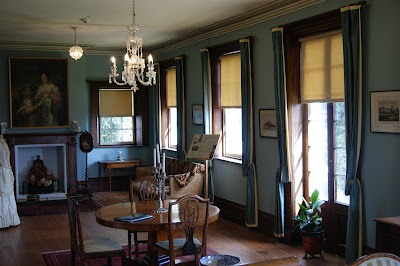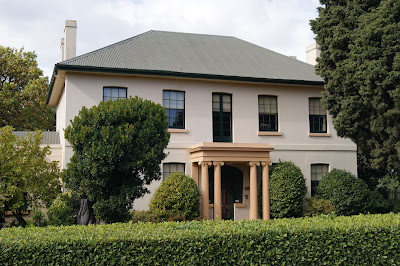They moved a number of times before moving to Long Meadows (the original name of Franklin Village) where he became the licensee of the “Sir William Wallace Inn" in 1834. The inn had previously been known as “The Punchbowl”, built in 1830 and owned by Charles Lucas who lost his license for harbouring assigned servants. As an innkeeper and brewer, Britton Jones delivered his beer and spirits around Launceston’s muddy streets in a bullock cart.
In 1834, Britton Jones had built the property now known as “Greycliffe” and originally called it “Prospect Hill” By 1838, Britton Jones purchased 10 acres of land almost opposite the Sir William Wallace Inn and constructed what is now known as Franklin House, an early Victorian Greek Revival style building constructed by convict labour from bricks made on the site. The interior joinery was made from Australian cedar bought in especially from northern New South Wales.
Built as a gentleman’s modest town house, it was leased on completion to solicitor Mr G. Horne as a family residence. In 1842 it was leased by an English schoolmaster, Mr William Keeler Hawkes who ultimately purchased the house in 1848 for the sum of 800 pounds. By that time the property had been sub-divided and now amounted to about 6 acres. Hawkes added a single storey schoolroom and established a boarding school for boys. The school was known as the “Classical & Commercial School” or more popularly known as “Mr Hawkes Academy” and catered for up to 26 students. It operated until about 1866.
The Hawkes family occupied Franklin House until 1888 when the last of Hawkes’ three maiden sister, Charlotte, died there. The house then passed to a succession of owners who used the house as a family home – Mr & Mrs William Lyon Shaw Greer (1888 – 1910) and Mr & Mrs Charles Kelly (1919 – 1941).Both these families took a leading part in community affairs at Franklin Village.
The house changed hands twice before 1960, firstly being owned by Mr H L Von See (1941 – 1945) and then by the Poole family (1945 – 1960). By this time the property was run down and was offered for sale as a light industrial site. It was considered to be more valuable if sold for that purpose as light industry was rapidly establishing in the Franklin Village area.
However, a group of concerned Launceston citizens believed the house should be saved for its heritage value and raised money to purchase, restore and furnish the house as a signature house in Franklin Village. The house, which had been known as “The Hollies” was renamed “Franklin House” to honour the memory of Sir John Franklin. It was opened to the public as a house museum in October 1961. The group that had formed to save the building, led by Mrs Edith Craig & Mr Dick Green became the National Trust in Tasmania.
It is certainly a stunning property and a major part of the Franklin Village streetscape and history. Well worth stopping in and taking the time to explore this magnificent building and surrounding grounds!
Main Text & Information Source –
“Franklin Village – A Journey in Time” – Terry Childs (Revised Edition 2013)
Available to purchase at the Franklin House onsite shop
Historic Photos –





























